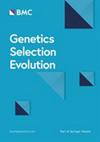评价提高非洲小农牛场适应能力和生产力的杂交策略
IF 3.1
1区 农林科学
Q1 AGRICULTURE, DAIRY & ANIMAL SCIENCE
引用次数: 0
摘要
杂交育种在世界范围内成功地实施,以提高动物的生产力和适应性。然而,杂交育种方案在非洲国家屡屡失败,这意味着需要为占主导地位的小农生产系统设计有效战略。一个综合的模拟程序模拟了本地牛磺酸牛品种和外来牛品种(分别为BWE和TCE)的体重(BWL)和蜱虫计数(TCL)发生率。这两个品种杂交产生F1和轮转动物。此外,采用农场公牛(FB)、村内公牛(IVB)、交换村公牛(EVB)和全种群公牛(PWB) 4种方案创建了合成品种。这些方案反映了选择和分配公牛到小农农场的不同策略。通过性状间的遗传相关性($${r}_{g}$$ =−0.4,0,0.4),本地环境与外来环境间的基因型环境效应(GxE) ($${r}_{g\times e}$$ = 0.4, 0.6, 0.8),以及选择指数(SI_TCL10)中TCL相对于BWL的相对重要性,将不同杂交品种与本地品种进行20代的比较%, SI_TCL30%, SI_TCL50%). Regardless of $${r}_{g}$$ and $${r}_{g\times e}$$ , EVB achieved the highest phenotypic and genetic gains for BWL and TCL over the 20 generations with SI_TCL50%. However, EVB displayed lower phenotypic means than F1 crosses in the first seven generations due to the loss of heterosis. Additive genetic variances were generally larger in synthetic crosses than in F1 and local animals, explaining the larger responses to selection. In addition, the EVB was the most effective strategy to stabilize inbreeding and retain heterosis in the advanced generations of synthetic animals. Low emphasis on TCL (SI_TCL30%, SI_TCL10%) resulted in negative phenotypic gain for TCL in synthetic animals when rg = − 0.4. In contrast to F1 and rotational crosses, GxE effects did not affect phenotypic gain in synthetic crosses. The study demonstrates opportunities for long-term genetic improvement of adaptive and productive performances in smallholder cattle farms using synthetic breeding. Extensive exchange of semen between villages or regions controls inbreeding and additionally contributes to increasing genetic gain. Furthermore, the definition of a suitable selection index prevents antagonistic selection responses caused by negative correlations between traits and GxE effects.本文章由计算机程序翻译,如有差异,请以英文原文为准。
Evaluation of crossbreeding strategies for improved adaptation and productivity in African smallholder cattle farms
Crossbreeding is successfully implemented worldwide to improve animal productivity and adaptability. However, recurrent failures of crossbreeding programmes in African countries imply the need to design effective strategies for the predominant smallholder production systems. A comprehensive simulation procedure mimicked body weight (BWL) and tick count (TCL) incidence in a local taurine cattle breed and in an exotic indicine beef cattle breed (BWE and TCE, respectively). The two breeds were crossed to produce F1 and rotational animals. Additionally, synthetic breeds were created by applying four schemes defined as farm bull (FB), intra-village bull (IVB), exchanged-village bull (EVB), and population-wide bull (PWB) scheme. These schemes reflect different strategies to select and allocate bulls to smallholder farms. The different crosses were compared with the local breed over 20 generations by varying the genetic correlation between the traits ( $${r}_{g}$$ = − 0.4, 0, 0.4), genotype-by-environment effects (GxE) between local and exotic environment ( $${r}_{g\times e}$$ = 0.4, 0.6, 0.8), and the relative emphasis of TCL compared to BWL in a selection index (SI_TCL10%, SI_TCL30%, SI_TCL50%). Regardless of $${r}_{g}$$ and $${r}_{g\times e}$$ , EVB achieved the highest phenotypic and genetic gains for BWL and TCL over the 20 generations with SI_TCL50%. However, EVB displayed lower phenotypic means than F1 crosses in the first seven generations due to the loss of heterosis. Additive genetic variances were generally larger in synthetic crosses than in F1 and local animals, explaining the larger responses to selection. In addition, the EVB was the most effective strategy to stabilize inbreeding and retain heterosis in the advanced generations of synthetic animals. Low emphasis on TCL (SI_TCL30%, SI_TCL10%) resulted in negative phenotypic gain for TCL in synthetic animals when rg = − 0.4. In contrast to F1 and rotational crosses, GxE effects did not affect phenotypic gain in synthetic crosses. The study demonstrates opportunities for long-term genetic improvement of adaptive and productive performances in smallholder cattle farms using synthetic breeding. Extensive exchange of semen between villages or regions controls inbreeding and additionally contributes to increasing genetic gain. Furthermore, the definition of a suitable selection index prevents antagonistic selection responses caused by negative correlations between traits and GxE effects.
求助全文
通过发布文献求助,成功后即可免费获取论文全文。
去求助
来源期刊

Genetics Selection Evolution
生物-奶制品与动物科学
CiteScore
6.50
自引率
9.80%
发文量
74
审稿时长
1 months
期刊介绍:
Genetics Selection Evolution invites basic, applied and methodological content that will aid the current understanding and the utilization of genetic variability in domestic animal species. Although the focus is on domestic animal species, research on other species is invited if it contributes to the understanding of the use of genetic variability in domestic animals. Genetics Selection Evolution publishes results from all levels of study, from the gene to the quantitative trait, from the individual to the population, the breed or the species. Contributions concerning both the biological approach, from molecular genetics to quantitative genetics, as well as the mathematical approach, from population genetics to statistics, are welcome. Specific areas of interest include but are not limited to: gene and QTL identification, mapping and characterization, analysis of new phenotypes, high-throughput SNP data analysis, functional genomics, cytogenetics, genetic diversity of populations and breeds, genetic evaluation, applied and experimental selection, genomic selection, selection efficiency, and statistical methodology for the genetic analysis of phenotypes with quantitative and mixed inheritance.
 求助内容:
求助内容: 应助结果提醒方式:
应助结果提醒方式:


